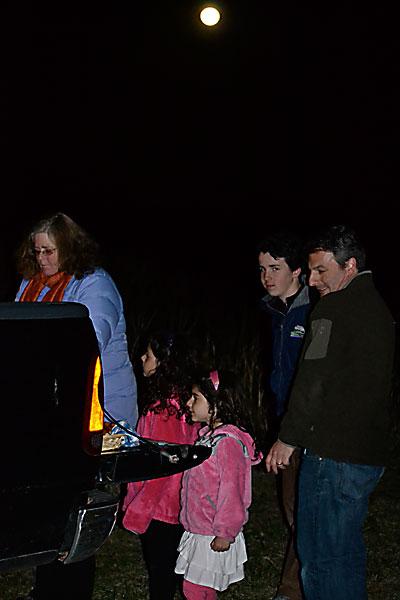By the Light of the Fish Moon

Jean Dodds, secretary of the Friends of the Long Pond Greenbelt, anxiously hoped the moon would cooperate as two dozen hikers gathered in the parking lot of the South Fork Natural History Museum in Bridgehampton Friday for the monthly full moon hike she led.
The trail was said to be easy and flat, with a few bumps and vines the only obstacles on the walk through the 39-acre Vineyard Field in the Greenbelt preserve. The open field area, formerly a vineyard, is surrounded by oak woods and is part of a greenbelt that runs from Sagg Pond and Sagg Swamp in Sagaponack all the way north to Sag Harbor.
The first full moon in April was named the Fish Moon by coastal Native American tribes, according to Ms. Dodds, because it coincided with the time that fish, especially alewives, swam upstream to spawn. The walk brought sounds of a woodcock, and Ms. Dodds had walkers visualize life in the ponds passed on the hike, since they could not be seen until the large, orange-pink moon rose above the trees. Two of the four small, unnamed ponds in the field were built by farmers for irrigation, Ms. Dodd explained. One was dug in the 1940s and the other in the 1980s. The ponds are home to many birds, reptiles, and mammals, including the Eastern tiger salamander, an endangered species.
“We are trying to bring back the alewives,” said Ms. Dodds. This project is one of the goals of the Friends of the Long Pond Greenbelt, in addition to attending to the restoration of grasslands that have been negatively impacted by invasive species, including autumn olive, Japanese knotweed, garlic mustard, mugwort, mile-a-minute vine, and purple loosestrife. The invasive plant species have blocked the existing public trail, and they threaten the rare old-field ecosystem, which comprises ponds, wetlands, wildflowers, and native grasslands, according to Eric Salzman, a member of the South Fork Natural History Museum’s board of directors. Restoration of the grasslands benefits rare and endangered native plants, mammals, reptiles, and amphibians, as well as butterflies, bees, dragonflies, damselflies, and many species of meadow-loving birds.
When the Friends of the Long Pond Greenbelt recognized that restoration was beyond the scope of volunteer efforts, the organization applied for grants and received funding from many private and public sources. With this money, autumn olives spread across 10 acres were removed by a professional land clearing company in late 2006. Twenty more acres with thick autumn olive stands were cleared in 2007 and early 2008. Concurrently, volunteers continue to remove, by hand, Japanese knotweed, garlic mustard, and other invasives.
Benefits to the public include new trailheads, pointed out by the hike leader, that are accessible from the field behind the museum, such as a six-mile trail that leads hikers to the ocean in Sagaponack. Ms. Dodds also pointed out different stars, planets, and constellations before the hike ended with hot cider, cake, and cookies served on a tailgate in the moonshine.
